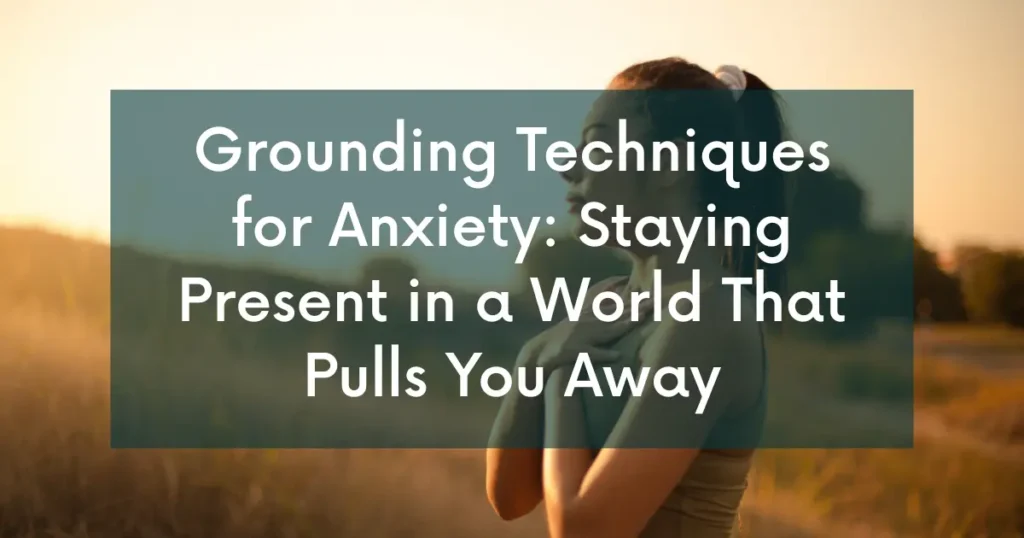
Grounding Techniques for Anxiety
Grounding Techniques for Anxiety and How to Stay Present in a World That Pulls You Away
When anxiety floods the mind with fear or pulls the body into panic, grounding techniques help you come back to the present moment. Whether it’s naming things you see, walking barefoot on grass, or focusing on your breath, grounding offers real, science-backed relief.
At Amend Treatment, we support using grounding techniques for anxiety to help clients reconnect to their bodies and feel safe again.
Introduction: Anxiety Lives in the Future. Grounding Brings You Back.
Anxiety is a forward-facing emotion. It races ahead, scanning for danger, rehearsing worst-case scenarios, and pulling your thoughts away from where you are right now.
Grounding techniques are powerful tools for staying present—especially during moments of panic, dissociation, or emotional overwhelm. At their core, these practices help you connect to your immediate physical experience, which sends safety signals to the brain and nervous system.
At Amend Treatment, we teach and practice grounding every day. It’s a foundational part of helping people return to themselves, especially those who’ve spent years managing anxiety, trauma, or chronic stress.
What Are Grounding Techniques for Anxiety?
Grounding techniques are intentional actions that help shift attention away from distressing thoughts and into the present. They’re especially helpful when emotions become overwhelming or the body moves into fight-flight-freeze mode. According to Anxiety Canada, grounding practices are most effective when they focus on sensory awareness, movement, or mental redirection.
Here are three major types:
Sensory-Based Grounding
The most well-known sensory technique is the 5-4-3-2-1 method, where you:
- Name 5 things you can see
- Name 4 things you can touch
- Name 3 things you can hear
- Name 2 things you can smell
- Name 1 thing you can taste
This slows your breathing and interrupts the anxiety spiral by anchoring you to your environment.
Physical Movement
Simple movement can be deeply regulating:
- Walking barefoot on a natural surface
- Gentle stretching or yoga
- Splashing cool water on your face
- Holding an object and describing it aloud
Touch and movement stimulate sensory input that activates the parasympathetic nervous system—your body’s built-in brake pedal.
Mental Grounding
These techniques engage the thinking mind just enough to redirect anxious energy:
- Counting backward by 7
- Naming categories (e.g., “types of dogs,” “TV shows from childhood”)
- Reciting a favorite poem or mantra
These mental anchors can reduce panic symptoms and restore a sense of focus.
For a full list of strategies, see the Cleveland Clinic’s list of grounding techniques, which highlights options for trauma survivors and those with high distress.
When Does Grounding Help?
Grounding is useful across a range of anxiety-related experiences, including:
- Panic attacks
- Dissociation or “spacing out”
- Social anxiety
- Overwhelm during conflict or overstimulation
- Flashbacks or intrusive memories
As explained by the National Center for PTSD, grounding can also be effective during post-trauma activation, helping people reorient when emotions or memories take over.
The Science of Grounding: Why It Works
Grounding is not just a coping mechanism—it’s backed by neuroscience. When you engage the senses or direct your attention to the body, you stimulate the vagus nerve, which helps shift the nervous system from fight-or-flight into a calmer, regulated state.
This sensory input increases interoception (awareness of the body’s internal state), which is associated with:
- Lowered heart rate and blood pressure
- Reduced amygdala reactivity (your brain’s fear center)
- Increased prefrontal cortex activation (executive function, decision-making)
Over time, regular grounding practices can help retrain the nervous system to recover more quickly from stress.
How Amend Incorporates Grounding into Treatment
At Amend Treatment, grounding isn’t an afterthought—it’s built into every aspect of care. For Clients managing anxiety, trauma, or dissociation, we introduce grounding techniques early in the therapeutic process as a way to create emotional safety.
Here’s how we do it:
- In Therapy: Therapists model and teach grounding tools that match each Client’s comfort and regulation level.
- In Group Settings: Grounding is used to start or close out sessions, especially in somatic, mindfulness, or process groups.
- In the Environment: Natural textures, access to the outdoors, and calming interior design all promote sensory regulation.
- In Movement: Clients are invited to walk, stretch, or pause outside as part of daily routines.
Because anxiety often disconnects people from their bodies, grounding helps build back that bridge—gently, patiently, and in a way that restores trust.
You Deserve to Feel Present and Safe
Anxiety doesn’t have to run the show. Grounding is a simple, science-supported way to come back to your breath, your body, and your life. Whether you’ve been living in hypervigilance for years or are just beginning to name what you’re feeling, grounding can help you come home to yourself.
At Amend, we teach these skills not just in therapy, but in life—because you deserve that kind of everyday support.
Contact us to learn how Amend Treatment can support your healing journey with trauma-informed, grounding-based care.
